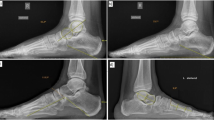Abstract
Purpose
The height of navicular bone from the floor is in proportion with the height of longitudinal arch of the foot. The study was conducted to evaluate correlation of navicular bone height with most often used angles, heel valgus and a foot print in order to simplify the procedure for the diagnosis of flatfoot.
Methods
A total of 218 operated children (436 feet) because of flexible flatfoot were evaluated clinically and radiologically. Meary angle, lateral talonavicular angle, talocalcaneal angle, calcaneal pitch, heel valgus and arch index (Staheli) were evaluated pre-operatively and postoperatively. In 121 (242 feet) chosen children (age eight to 15) with all clinical values and pre-operative angles corresponding flatfoot, all postoperatively measured values were within the normal range. We got the navicular index by dividing length of longitudinal arch with navicular height. Values of navicular index were then compared with pre-operatively and postoperatively measured values. Pearson correlation and ROC test were used for statistical analysis.
Results
Values of the navicular index for flatfeet were in the interval from 4.75 to 31.2 (median 8.98), and for normal-arched feet 3.58–22.6 (median 5.48). Pearson correlation of arch index and measured parameters were significant in majority, and degree according to Colton was good. Area under the ROC curve was 0.861 (p = 0.0001). The cut-off value with 86 % sensitivity and 75 % specificity was 6.7407.
Conclusion
Navicular index can be used reliably, without measures of the other parameters, to differentiate flatfoot from normal-arched foot. Therefore, the navicular index has an ability to distinguish between the flatfoot and normal-arched foot.


Similar content being viewed by others
References
Lovett HW, Dane J (1896) The affections of the arch of the foot commonly classified as flat-foot. J Bone Joint Surg Am s1–8:78–92.
Pauk J, Griskevicius J (2011) Ground reaction force and support moment in typical and flat-feet children. Mechanika 17:93–96
Foot Health Facts. The official consumer website of American College of Foot and Ankle Surgeons™. http://www.foothealthfacts.org/footankleinfo/pediatric-flatfoot.htm (accessed 30/09/2012).
Trott AW (1982) Children’s foot problems. Orthop Clin North Am 13:641–654
Caselli MA, Sobel E, McHale KA (1998) Pedal manifestations of musculoskeletal disease in children. Clin Podiatr Med Surg 15:481–497
Harris EJ (2000) The oblique talus deformity. What is it, and what is its clinical significance in the scheme of pronatory deformities? Clin Podiatr Med Surg 17:419–442
Hefti F (1999) Foot pain. Orthopade 28(2):173–179
Kumar SJ, Cowell HR, Ramsey PL (1985) Foot problems in children. Part 1. Vertical and oblique talus. Instr Course Lect 31:235–251
Kumar SJ, Ramsey PL (1977) Vertical and oblique talus (a diagnostic dilemma). Orthop Trans 1:108
Sullivan JA (1999) Pediatric flatfoot (evaluation and management). J Am Acad Orthop Surg 7:44–53
Tonnis D (1986) Skewfoot. Orthopade 15:174–183
Harris EJ, Vanore JV, Thomas JL et al (2004) Diagnosis and treatment of pediatric flatfoot. J Foot Ankle Surg 43:341–373
Roth S, Sestan B, Tudor A, Ostojic Z, Sasso A, Durbesic A (2007) Minimally invasive calcaneo-stop method for idiopathic, flexible pes planovalgus in children. Foot Ankle Int 28(9):991–995
Roth S (2007) Minimal invasive calcaneo-stop method in cases of pes planovalgus in childhood with “BoneStar®” implant. J Child Orthop 1(suppl 1):25
Roth S, Durbesic A, Bajok I (2011) Treatment of the flexible flatfoot in children with the modified calcaneo-stop method with BoneStar® implant. J Child Orthop 5(suppl 1):S1–S35
Kellermann P, Roth S, Gion K, Boda K, Tóth K (2011) Calcaneo-stop procedure for paediatric flexible flatfoot. Arch Orthop Trauma Surg 131(10):1363–1367
Gillham EM (2001) A life of Sir Francis Galton: from African exploration to the birth of Eugenics, 1st edn. Oxford University Press, Oxford, p 432
Colton T (1974) Statistics in medicine, 1st edn. Little: Brown & Company, Boston, pp 372
Zhou XH, McClish DK, Obuchowski NA (2011) Statistical methods in diagnostic medicine, 2nd edn. Wiley, New York, p 545
DeLong ER, DeLong DM, Clarke-Pearson DL (1988) Comparing the areas under two or more correlated receiver operating characteristic curves: a nonparametric approach. Biometrics 44:837–845
Williams DS, McClay IS (2000) Measurements used to characterize the foot and the medial longitudinal arch: reliability and validity. Phys Ther 80:864–871
Shrader JA, Popovich JM Jr, Gracey GC et al (2005) Navicular drop measurement in people with rheumatoid arthritis: interrater and intrarater reliability. Phys Ther 85:656–664
Murley GS, Menz HB, Landorf KB (2009) A protocol for classifying normal- and flat-arched foot posture for research studies using clinical and radiographic measurements. J Foot Ankle Res 2:22
Graham ME, Jawrani NT, Chikka A (2011) Radiographic evaluation of navicular position in the sagittal plane-correction following an extraosseous talotarsal stabilization procedure. J Foot Ankle Surg 50:551–557
Cornwall MW, Mc Poil TG (1999) Relative movement of the navicular bone during normal walking. Foot Ankle Int 20:507–512
Conflict of interest statement
All authors disclose any potential conflicts of interest, including specific financial interests relevant to the subject of their manuscript.
Competing interests
None.
Funding
This work was supported by grants from the Primorsko-goranska County of the Republic of Croatia.
Ethics approval
The study was approved by the Medical ethics committees of the Clinical Hospital Center Rijeka, and School of Medicine, University of Rijeka, Croatia.
Author information
Authors and Affiliations
Corresponding author
Rights and permissions
About this article
Cite this article
Roth, S., Roth, A., Jotanovic, Z. et al. Navicular index for differentiation of flatfoot from normal foot. International Orthopaedics (SICOT) 37, 1107–1112 (2013). https://doi.org/10.1007/s00264-013-1885-6
Received:
Accepted:
Published:
Issue Date:
DOI: https://doi.org/10.1007/s00264-013-1885-6




